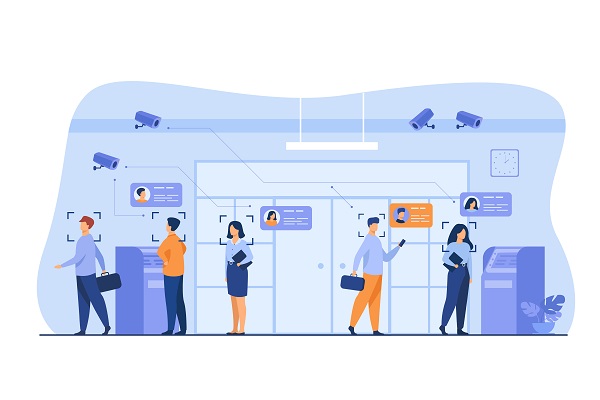In Brazil, the use of facial recognition cameras for public security is growing. This trend is fomenting debates, supporters advocate its use due to the benefits it can bring to the work of police forces in alerting crimes, identifying suspects and more. Meanwhile, detractors raise questions regarding privacy, abuse of power by governments and system reliability. The creation of laws, specific regulations and improvements in algorithms may be an initial response to the issues posed by this tool that seems to be here to stay.
FACIAL RECOGNITION CAMERAS FOR PUBLIC SECURITY IN BRAZIL
Facial recognition cameras are already present in 20 Brazilian states, according to a report by Folha de S. Paulo from June 2021. Even though its use dates to 2011, it was only between 2018 and 2019 that a great expansion began. In this period, cameras were installed in Salvador (BA), and they helped in the arrest of 209 fugitives until June 2021. In 2019, Rio de Janeiro (RJ) started its own project with cameras scanning faces of people in Copacabana’s Carnival blocos. During the project’s first 4 months, it helped arrest 63 criminals.
In 2022, new projects continue to appear. In February, Rio Branco (AC) and Vitória (ES) announced the installation of monitoring cameras with facial recognition capabilities. Acre’s capital will have 430 new cameras, 18 capable of searching for faces of criminals. Espírito Santo’s capital will place 150 units with this feature across several strategic points. In Rio de Janeiro, since January, the police is planning to spread 22 of these devices across Jacarezinho favela. The initiative is part of Cidade Integrada project, which attempts to replace the UPP project.
THE TECHNOLOGY AND ITS BENEFITS TO PUBLIC SECURITY
All recognition systems have the same principle: detect a face in geometric and algorithmic shapes. They identify, through a camera, points of reference: eyes, the distance between them, nose etc. These points, biometric data, are stored in a database, which recognize them through calculations. To detect a criminal in the crowd, the system compares the biometrics of those being monitored with a database of wanted persons. As everything is done quite fast, these systems are seen as a great tool for the overstretched police forces in Brazil.
Besides multiplying the capacity of vigilance, this technology can enhance investigative powers, since cameras can track a person’s history of movement and those with whom he/she met with. Furthermore, this tool could make it easier to find missing people, or work as a deterrence, especially for petty crimes. Those in favor, also argue that it is already being widely used by private companies at airports, condominiums and more. Thus, the use for public security would only be just another one.
CONTROVERSIES
On March 3rd, civil entities and public defenders filed a public civil action to prevent the São Paulo Metro from mapping and monitoring the faces of 4 million daily users through facial recognition technologies. This is one example of many acts of resistance that are emerging with the wider use of such feature. Most criticisms are based on the argument that the social and freedom costs of this type of surveillance outweigh the security it can promote. Many believe that such tool could lead to a mass surveillance, and in the hands of an authoritarian government, it can serve to control any dissenting voices. After the creation of a Social Credit System (SCS), China is often mentioned as an example. The SCS uses the technology to monitor citizens and attribute a grade to each one based on their behavior within the public space.
Other criticisms include the cases of identification errors and the racial bias some algorithms have. For instance, in 2019, a woman was wrongly identified and arrested in Copacabana. In 2020, a similar incident happened in Bahia with a man. A survey in England, during the 2017 UEFA Champions League, found out that out of 2.470 potential criminals identified, only 173 were correct. A study from the National Institute of Standards and Technology (NIST) indicated that chances of false positives were up to 100 times higher for Asians and Africans than to Caucasians. Still, there is the issue of the protection of the biometric data, which could leak or be stolen. In Brazil, specifically, there is the lack of regulation for the use in public security.
POSSIBLE WAYS TO MINIMIZE CONTROVERSIES
According to a survey by the tech company ReportLinker, the use of facial recognition will grow 17,8% globally until 2025. The forecast might indicate that this tech is here to stay. To improve coexistence with it, better technologies, and specific adaptations of the algorithms to ethnic differences of each location may come in handy. Furthermore, regulation regarding procedures and standards for its use in public security in Brazil can also be crucial.
In September 2020, the General Data Protection Law (LGPD), was approved, and it might be a first step into this path of more efficiency and less issues. Even though a specific regulation for use in public security has not come out yet, the LGPD sets a reference. It regulates the use of personal data, including biometrics, by public and private organizations to prevent theft, leaks, and illegal sales. It works as a standard for companies who wish to improve their security systems and avoid legal liabilities as well. The National Authority for Data Protection (ANPD), a regulatory body, will also help by monitoring compliance with the law and punishing those who disobey.



